| Columns Retired Columns & Blogs |
VTL Compact 160 monoblock power amplifier Measurements
Sidebar 2: Measurements
Footnote 1: I note with interest recent articles in The Absolute Sound and Stereo Review implying that this response-modifying interaction between the loudspeaker and the amplifier's output impedance has hitherto been overlooked. Overlooked it may have been in those two publications, but I remember discussing it in Hi-Fi News & Record Review more than 10 years ago, and it has been examined regularly in individual Stereophile reviews. My January 1991 report on the Avalon Eclipse loudspeaker, for example, went into the subject in some detail. One point should be noted regarding E. Brad Meyer's article on this subject in the June 1991 Stereo Review, where he implied that all audible amplifier differences are due to this effect. If this is even partly true, why then did Stereo Review's early-1987 blind listening tests produce a null result? One amplifier in that test, the NYAL OTL, had a much higher output impedance than the others, so the fact that it wasn't identified suggests that the entire test procedure and conditions were not conducive to good aural discrimination. I don't know why I should be surprised by this, however. People in general tend not to find what they are not looking for.—John Atkinson
Unlike the EL34-equipped Compact 100s that I favorably reviewed a couple of years back (Vol.11 No.11), the Compact 160s have this front-panel switch to switch between pentode and triode modes. Nice for the listener; awkward for the reviewer who therefore has to measure every aspect of performance twice. I'll try to concentrate on the differences between the two modes, but bear with me if the words "pentode mode" and "triode mode" pop up rather frequently.
Looking first at output impedance, the 160 is a typical classic tube design in that it doesn't much act as a voltage source. In triode mode, the output impedance ranged from 1.5/1.7 ohms at 20Hz to 1.4/1.6 ohms at 1kHz, and 1.35/1.55 ohms at 20kHz (measurements respond to serial numbers '306/'305, respectively). These figures suggest that there will be some modification of the loudspeaker's response depending on the manner with which the load changes with frequency (footnote 1) (see later). In pentode mode, the amplifier's output impedance was even higher: I measured 2.15/2.4 ohms at 20Hz, 2.05/2.3 ohms at 1kHz, and 2.0/2.2 ohms at 20kHz. This higher source impedance in pentode mode will restrict the voltage swing into lower-impedance loads, which means that the Compact 160 will actually appear more powerful into these impedances in triode mode.
The Compact 160's input impedance was 75k ohms, with a voltage gain (into 8 ohms) of 29.8dB (pentode) or 26.7dB (triode). The amp is polarity-correct—non-inverting—and the unweighted S/N ratio (ref. 1W/8 ohms) was good at 64dB/66.5dB (305/306, respectively). Sensitivity was reasonably high (together with the high input impedance making these amps suitable for use with a passive control unit), though a little lower than previous VTL amps. In either mode, just over 1V was required to drive the amp to a 3% THD clipping point.
I used a 3% THD point because the manner in which the amplifier's distortion changes with level means that the normal 1% THD point doesn't always correspond with the onset of clip. Fig.1, for example, plots output power in triode mode for S/N '305 against THD+noise for 8, 4, and 2 ohm loads, with fig.2 showing the behavior of the same amp in pentode mode into 8 and 4 ohm loads. At the actual clip point, where the distortion curves in figs.1 and 2 develop a knee, the waveform appeared both to triangulate somewhat as well as become squared off, with the pentode mode developing a twin-horned appearance due to leading- and trailing-edge overshoot; see later. But the listener will be reaching for the volume control well below this point.
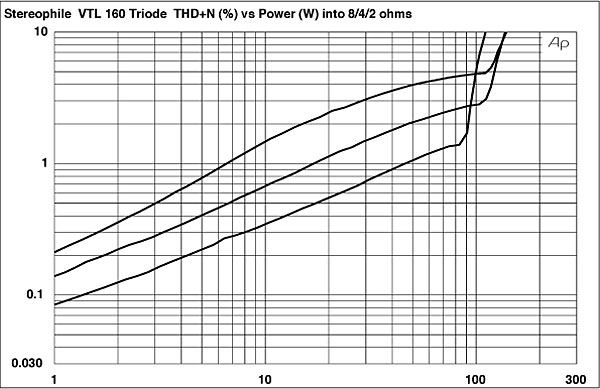
Fig.1 VTL Compact 160, S/N 305, triode mode, distortion (%) vs 1kHz continuous output power into 8 ohms (bottom), 4 ohms (middle), and 2 ohms (top).
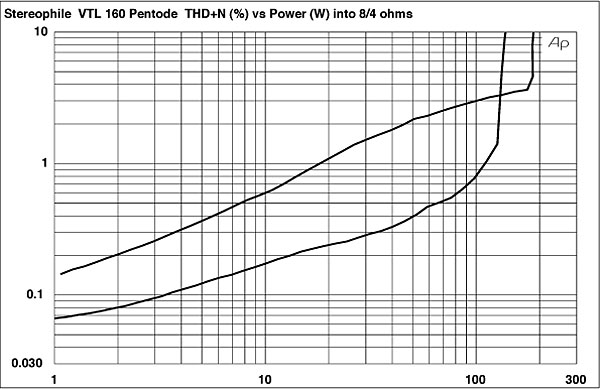
Fig.2 VTL Compact 160, S/N 305, pentode mode, distortion (%) vs 1kHz continuous output power into 8 ohms (bottom), 4 ohms (top).
Though distortion levels are respectably low at low powers into 8 ohms in either mode, they rise smoothly both with increasing power and with decreasing load impedance. This behavior probably explains why CG didn't feel the 160s to sound as powerful as he expected; their dynamic limit will be below the actual clipping point and will depend both on the type of music and on the speaker load the amplifiers are asked to drive. Fig.3 shows the modulus of impedance of CG's preferred Spica Angelus: it rarely drops below 8 ohms apart from a minimum of 5.2 ohms around a musically undemanding 8kHz. I conjectured in my Vol.11 No.2 review that the Angelus should work well even with highish-output-impedance tube amplifiers, and that appears to be the case here. Regarding the interaction between the 160 and CG's preferred Spica Angeli, its highish output impedance results in a variation of ±0.6dB (triode) and ±1dB (pentode) across the audio band (fig.4).
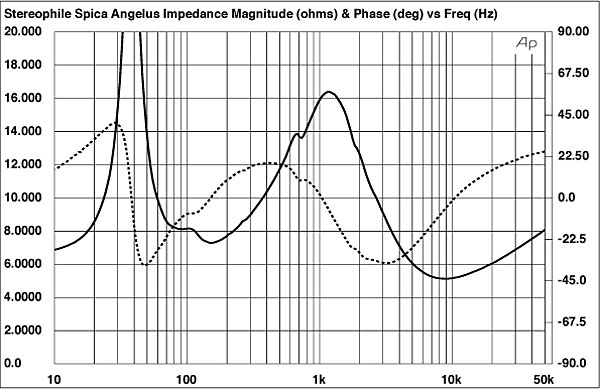
Fig.3 Spica Angelus, electrical impedance (2 ohms/vertical div.)
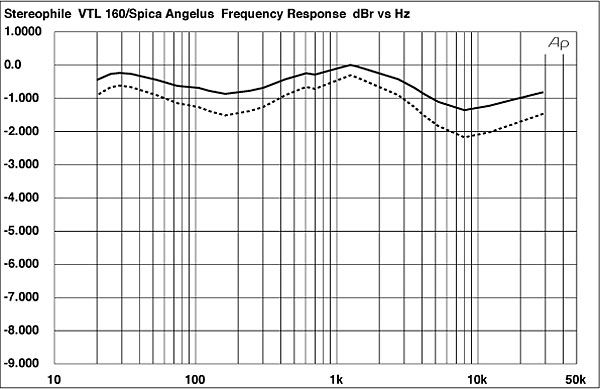
Fig.4 VTL Compact 160, effect of output imepdance on response of Spica Angelus speaker, pentode mode (dashed), triode mode (solid) (2dB/vertical div.).
The actual output powers at the 3% THD point for S/N '306 into 8 and 4 ohms were 130W (21.1dBW) and 100W (17dBW), pentode mode, and 95W (19.8dBW) and 105W (17.2dBW), triode mode. The 2-ohm power was restricted by the higher intrinsic distortion—just 31W (8.9dBW) being available in triode mode for 3% THD. Surprisingly, however, the amplifier would drive the 2 ohm load without fuses popping. Nevertheless, the Compact 160 shouldn't be asked to drive speakers that drop much below 8 ohms, in my opinion.
S/N '305 offered higher levels of distortion than '306, which meant that its maximum output power was less promising: again into 8, 4, and 2 ohm loads, the pentode mode gave 127W (21dBW), 50W (14dBW), and 11.5W (4.6dBW); the triode mode gave 95W (19.8dBW), 72W (15.6dBW), and 17.5W (6.4dBW), respectively. This amplifier's output bias was set a little lower than '306, at an average of 25mA triode/27mA pentode compared with 29mA/30.2mA, which might—I say might—correspond with the higher THD. If so, this would suggest that both the 160 and perhaps the KT90 tube are more sensitive than usual to slight changes in bias. VTL says in The Vacuum Tube Logic Book that the bias current can be increased to double and triple the factory-set figure, meaning that the amplifier's output stage operates nearer to class-A, but they warn that this increase is "to no sonic benefit" and do not recommend it. Nevertheless, it might be worth asking your VTL dealer to up the 160's bias current a little in order to squeeze as much headroom out of the amplifier as is possible.
I next looked at the way in which the 160's distortion changed with frequency at a nominal 2.83V output level into 8, 4, and 2 ohms. Fig.5 shows the results in pentode mode, fig.6 those in triode mode. Note again that one amplifier (305) offered higher levels than the other, which was respectably well-behaved across the audio band into 8 and 4 ohm loads. At low levels into 8 ohms, the distortion appeared to be mainly the innocuous second harmonic, as shown by fig.7, the lower trace of which shows the distortion and noise waveform with the fundamental notched out. The presence of second harmonic is surprising in a push-pull design, suggesting that the push and pull sides of the output stage are a little out of balance. Into lower impedances, higher even and odd harmonics appear, as can be seen by fig.8 (pentode and triode modes were almost identical in their behavior here) and fig.9, the latter showing regularly decreasing levels of low-order harmonics imposed on a 50Hz fundamental at a reasonably high output power into 4 ohms, this typical of a classic tube design.
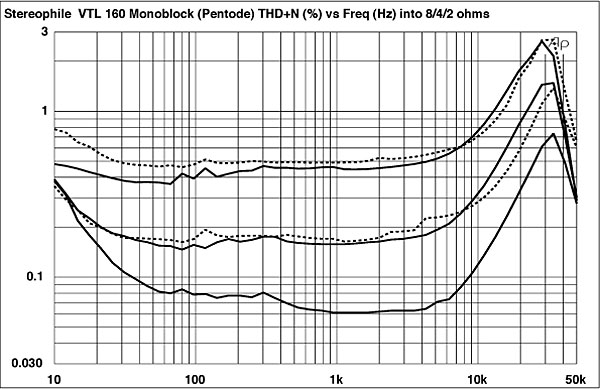
Fig.5 VTL Compact 160, pentode mode, THD+N (%) vs frequency at 2.83V into: 8 ohms (top), 4 ohms (middle), 2 ohms (top) ((S/N 305 dashed).
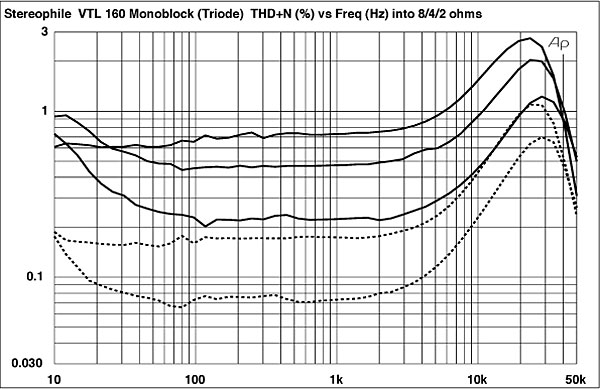
Fig.6 VTL Compact 160, triode mode, THD+N (%) vs frequency at 2.83V into: 8 ohms (top), 4 ohms (middle), 2 ohms (top) ((S/N 305 dashed).
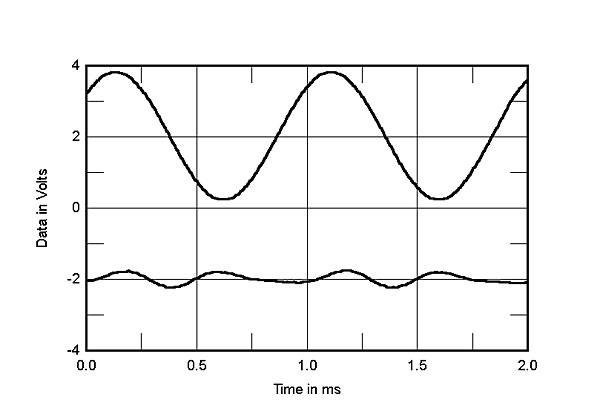
Fig.7 VTL Compact 160, pentode mode, 1kHz waveform at 1W into 8 ohms, (top); distortion and noise waveform with fundamental notched out (bottom, not to scale).
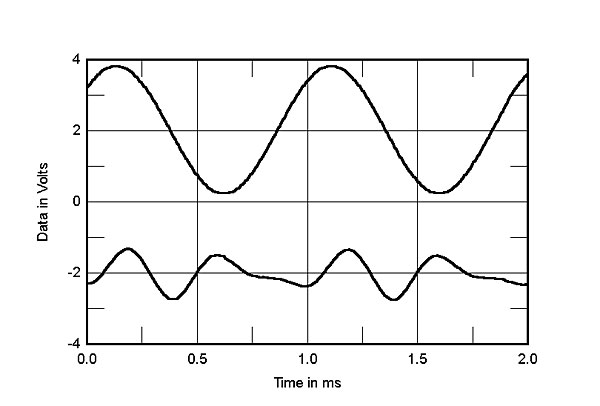
Fig.8 VTL Compact 160, pentode mode, 1kHz waveform at 2W into 4 ohms, (top); distortion and noise waveform with fundamental notched out (bottom, not to scale).
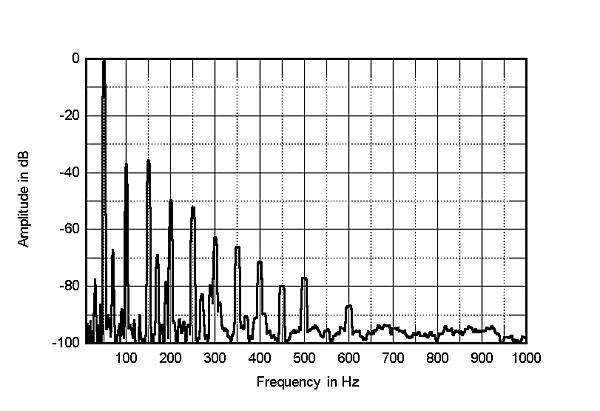
Fig.9 VTL Compact 160, triode mode, spectrum of 50Hz sinewave, DC–1kHz, at 41W into 8 ohms (linear frequency scale).
These distortion measurements suggest that while the VTL offers higher levels of distortion than a solid-state design at output powers of more than 30W or so, particularly into low-impedance loads, it does so relatively gracefully, the result being mainly the production of musically natural low-order harmonics. Levels of intermodulation distortion were a little higher than I would have liked to see, however. Fig.10 shows the audio-band spectrum of spuriae produced when the amplifier—in this case, the worse-measuring '305—was asked to drive a 1:1 mix of 19 and 20kHz tones at a level equivalent to 40W into 4 ohms in pentode mode. The 1kHz difference product appears at –40dB, 1%, as do the second-order 18kHz and 20kHz products. Again, this probably correlates with the Compact 160's somewhat limited power delivery compared with what one might expect from an amplifier labeled "160."
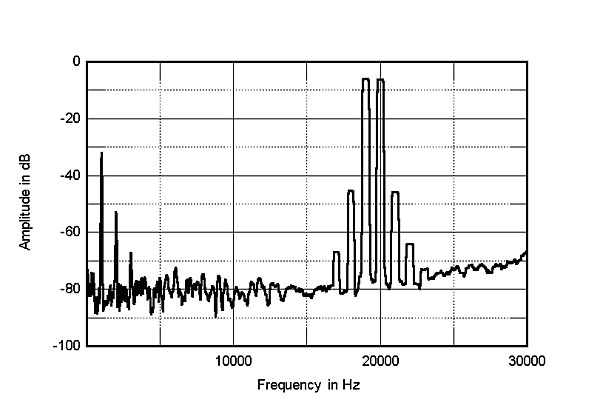
Fig.10 VTL Compact 160, pentode mode, HF intermodulation spectrum, DC–30kHz, 19+20kHz at 156W peak into 4 ohms (linear frequency scale).
I found the small-signal frequency response surprising in that it differed in the two modes, as can be seen from fig.11. While the amplifier was respectably flat across the audio band in triode mode (note also the excellent low-frequency extension), dropping to –3dB around 55kHz, a 2–3dB ultrasonic peak appeared in pentode mode just above 60kHz, suggesting an intrinsic, if damped, instability at this frequency. This can be seen in the manner in which the 160s handled squarewaves. Fig.12 shows a low-level 10kHz squarewave as reproduced by the amp in pentode mode; note the ringing on the leading edges. Though this is much better damped in triode mode (fig.13), there is still a degree of leading-edge overshoot present.
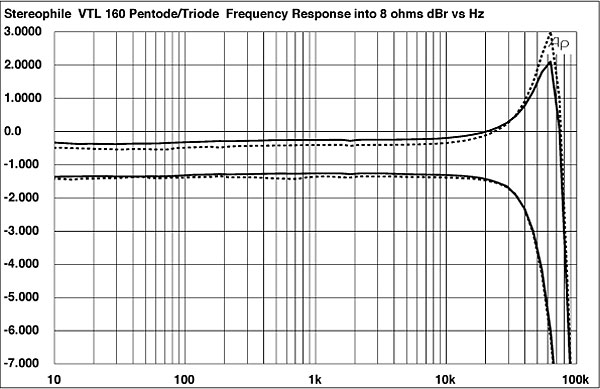
Fig.11 VTL Compact 160, frequency response at 1W into 8 ohms, pentode mode (top), triode mode (bottom) (S/N 305 dashed, 1dB vertical div.).
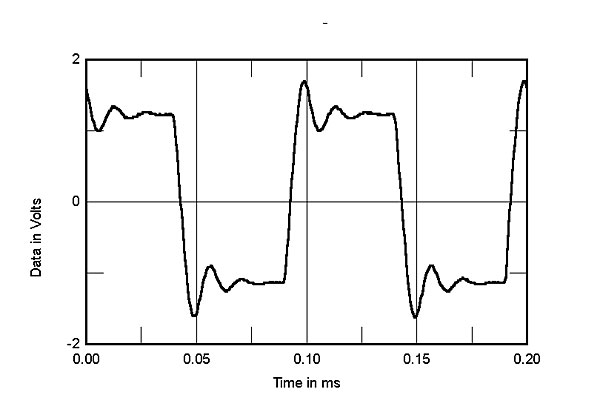
Fig.12 VTL Compact 160, pentode mode, small-signal 10kHz squarewave into 8 ohms.
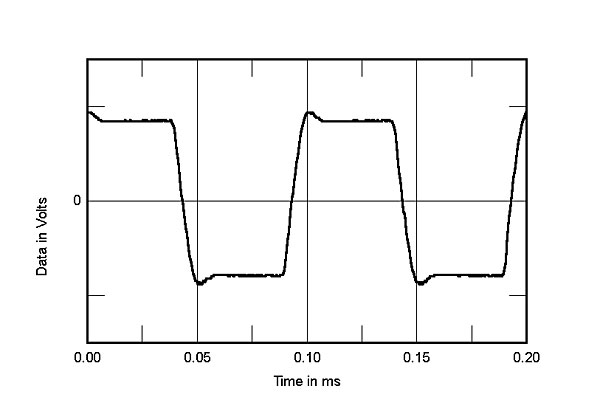
Fig.13 VTL Compact 160, triode mode, small-signal 10kHz squarewave into 8 ohms.
The VTL 160's measured performance is typically tube: high output impedance, relatively graceful overload, with the production of musically natural harmonics as the output voltage and current increase, with the dynamic limit probably set by the production of audible intermodulation products rather than by the hard clip point. It also seems to be both better behaved and better able to drive awkward speaker loads in triode mode. But to a larger extent than even other tube amplifiers, the Compact 160's overall behavior will depend on the loudspeaker with which it is to be used. Auditioning with the purchaser's own speakers is therefore essential.—John Atkinson
Footnote 1: I note with interest recent articles in The Absolute Sound and Stereo Review implying that this response-modifying interaction between the loudspeaker and the amplifier's output impedance has hitherto been overlooked. Overlooked it may have been in those two publications, but I remember discussing it in Hi-Fi News & Record Review more than 10 years ago, and it has been examined regularly in individual Stereophile reviews. My January 1991 report on the Avalon Eclipse loudspeaker, for example, went into the subject in some detail. One point should be noted regarding E. Brad Meyer's article on this subject in the June 1991 Stereo Review, where he implied that all audible amplifier differences are due to this effect. If this is even partly true, why then did Stereo Review's early-1987 blind listening tests produce a null result? One amplifier in that test, the NYAL OTL, had a much higher output impedance than the others, so the fact that it wasn't identified suggests that the entire test procedure and conditions were not conducive to good aural discrimination. I don't know why I should be surprised by this, however. People in general tend not to find what they are not looking for.—John Atkinson
- Log in or register to post comments



































